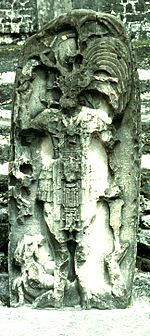Kaloomteʼ Bahlam facts for kids
Quick facts for kids Kaloomteʼ Bahlam |
|
|---|---|
| Ajaw | |

Stela 10 representing Kaloomteʼ Bahlam.
|
|
| King of Tikal | |
| Reign | 19 April 511 - c.527 (with co-ruler (wife?) Lady of Tikal) |
| Predecessor | Chak Tok Ichʼaak II |
| Successor | Bird Claw |
| Died | after c. 527 |
| Spouse | Lady of Tikal (possibly) |
| Religion | Maya religion |
| Signature | |
Kaloomteʼ Bahlam, also known as Curl Head, was an important leader of the ancient Maya city of Tikal. He became the ruler, or ajaw (pronounced ah-HAW), around the year 511 AD. Tikal was a very powerful city in what is now Guatemala.
Kaloomteʼ Bahlam ruled alongside a woman known as the Lady of Tikal. Together, they led the city during a period in the 6th century. He is remembered through large stone monuments called stelae, which tell us about his time as ruler.
Contents
Who Was Kaloomteʼ Bahlam?
Kaloomteʼ Bahlam was a significant ajaw of Tikal. An ajaw was like a king or a powerful lord in the Maya world. These leaders were in charge of their cities and the lands around them. They made important decisions for their people.
He took on the role of ruler around 511 AD. This was a time when many great Maya cities were thriving. His rule helped shape Tikal's history during this period.
Ruling Tikal
Tikal was one of the largest and most powerful cities of the ancient Maya. It had grand temples, palaces, and plazas. The ajaw of Tikal held a lot of influence over the region.
Kaloomteʼ Bahlam's rule was special because he shared power. He co-ruled with the Lady of Tikal. Sharing power was not always common among Maya rulers. This suggests a unique arrangement for Tikal at that time.
What is an Ajaw?
In Maya society, an ajaw was more than just a king. They were seen as a link between the people and the gods. They performed important religious ceremonies. They also led their cities in times of peace and war.
The ajaw was responsible for the well-being of their city. They oversaw building projects, farming, and trade. Their decisions affected the lives of everyone in their kingdom.
Monuments of Kaloomteʼ Bahlam
We know about Kaloomteʼ Bahlam from special stone carvings. These carvings are called stelae (pronounced STEE-lee). Stelae are tall, carved stone slabs. They were often set up in public places in Maya cities.
Stelae usually show important rulers or events. They have pictures and hieroglyphic writing. This writing tells us about the ruler's life, their victories, and important dates.
Stelae 10, 12, and 25
Three specific stelae are linked to Kaloomteʼ Bahlam. These are Stela 10, Stela 12, and Stela 25. Stela 10, for example, shows a figure believed to be Kaloomteʼ Bahlam himself.
These monuments give us clues about his reign. They help historians understand the history of Tikal. They also show us the artistic skill of the ancient Maya people.
What Do Stelae Tell Us?
Stelae are like giant history books made of stone. They record important moments. They might show a ruler holding a scepter, wearing fancy clothes, or standing over a defeated enemy.
The hieroglyphs on stelae often list dates. They also name other important people. By studying these stelae, experts can piece together the stories of ancient Maya rulers like Kaloomteʼ Bahlam.
The End of His Reign
Kaloomteʼ Bahlam ruled Tikal until at least 527 AD. The exact date of his death is not known. However, his time as ajaw left a mark on the city.
After his rule, another leader named Bird Claw took the throne. The history of Tikal continued to unfold. The city remained a powerful center for centuries.

